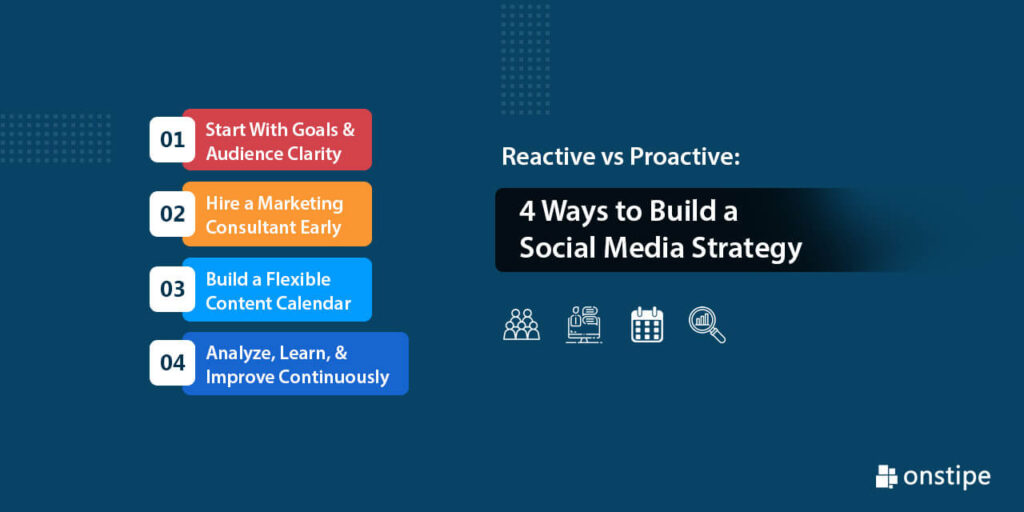Every business needs a presence online, but showing up in the right way is just as important as showing up at all. There are many ways to do that. Some brands prepare their content in advance and follow a steady plan. Others prefer to respond quickly to trends and conversations as they happen.
Both of these approaches work. But the question isn’t which one is better, it’s about finding what suits your needs.
In this article, you’ll learn how to bring both styles together in a way that supports consistent growth. The five steps ahead will help you build a strategy that feels simple, manageable, and connected to the way your brand communicates best.
Understand the Core Difference
Generally, there are two ways most businesses manage their content. First is reactive, and the second is proactive.
The first is through advance planning. This involves setting clear themes, publishing schedules, and message goals before anything is posted. It’s organized and focused, which helps your audience know what to expect.
The second is based on quick decisions. Content is shaped by what’s happening in real time, whether that’s a customer comment, a new topic in your industry, or a conversation happening in your niche. This approach is more flexible and makes the brand feel present.
4 Ways to Shape a Better Strategy
To build a strategy that truly works, start with the basics. Knowing what you’re aiming for and who you’re speaking to makes everything else easier.
● Start With Goals and Audience Clarity
The first step is understanding your business needs and what you want to deliver to your audience.
Do you want your content to be focused on increasing reach, driving sign-ups, encouraging shares, or starting more conversations? When you get this clarity, you pick the right tone and format for your content.
You also need to consider the people you’re speaking to. What do they respond to? What topics matter to them? What tone do they expect? These details make a difference in how your message is received.
● Hire a Marketing Consultant Early
When you have a clear goal in mind but things feel unorganized or hard to manage overall, it’s time to hold expert hands. This is where a professional consultant can help you build a clear plan and choose the right mix of content styles. This practice takes pressure off your team, saves time, and helps everything run more smoothly.
However, finding the right talent is not easy when everyone claims they are experts. To deal with this, you can check out dedicated platforms to find a marketing consultant with proven experience in your industry. You’re not left guessing. You also have the freedom to interview them. It’s your choice to hire them part-time, full-time, or just for a single project.
● Build a Flexible Content Calendar
Having a plan doesn’t mean every post needs to be decided weeks in advance. But some structure helps you stay organized and avoid last-minute gaps.
Start by outlining key moments. This might include product releases, seasonal updates, or ideas that reflect your values. These form the base of your calendar and help set a rhythm.
Leave space for topics that come up unexpectedly. This might be something relevant in your industry or a creative idea that feels right in the moment. Keeping some open slots allows you to stay flexible and current without falling off track.
When your content has a steady pace with room to shift, it feels thoughtful and natural at the same time.
● Analyze, Learn, and Improve Continuously
Once you’ve shared your content, take time to understand how it’s performing. Look at engagement, feedback, and activity over time. These signals help you see what connects and what needs adjustment.
Pay attention to both numbers and reactions. Are people clicking, saving, or commenting? Are they asking questions or sharing your content with others? These patterns offer useful direction for your next posts.
Build a habit of checking in regularly. A simple review every month is enough to guide small changes that lead to better results. As your audience and brand grow, your strategy will evolve too.
Conclusion
Creating a smart content strategy is not about choosing one way and ignoring the other. It’s about building a system that fits how your business works and how the audience is connected.
Consistency, clarity, and flexibility. With the right balance, your content can do more than fill a feed. It can support the brand’s growth and leave a lasting impression.
If you want expert support to make it, a skilled market consultant can help you build the structure you need, with the freedom to continue to adapt as you grow.







